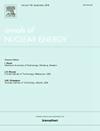Evaluation of thermal scattering law and cross sections for liquid hydrogen fluoride
IF 1.9
3区 工程技术
Q1 NUCLEAR SCIENCE & TECHNOLOGY
引用次数: 0
Abstract
Liquid anhydrous hydrogen fluoride (HF) is a material commonly used in fuel manufacturing and processing, and as a result it is of particular interest for criticality safety applications. In order to capture the thermal scattering impacts from this hydrogenous material, accurate thermal scattering law (TSL, i.e. S(α,β)) libraries were developed. Using classical molecular dynamics (MD) simulation of the liquid HF system, a parametrized three-site model was developed in the GROMACS MD code to accurately represent the hydrogen bond and capture the liquid’s interatomic structure. This computational model (referenced as the NCSU HF model) was constructed with a massless charge to capture the hydrogen bonds between molecules. The accuracy of the NCSU HF model was verified by comparing its predictions of various HF properties with experimental data for the hydrogen and fluorine bond length, density, potential energy, dipole moment, and diffusion coefficient. From this model, the primary inputs of the phonon density of states (DOS) and liquid diffusion properties were derived for use in the Full Law Analysis Scattering System Hub (FLASSH) to evaluate the TSL for both H(HF) and F(HF). These TSL libraries were benchmarked using the ICSBEP HEU-SOL-THERM-039 critical assembly benchmark, showing notable improvement on the order of 1170 pcm. The libraries generated in this work have been accepted in the ENDF/B-VIII.1 nuclear data release.
液态氟化氢的热散射规律及散射截面的评定
液体无水氟化氢(HF)是一种通常用于燃料制造和加工的材料,因此它对临界安全应用特别感兴趣。为了捕捉这种含氢材料的热散射影响,建立了精确的热散射定律(TSL,即S(α,β))文库。利用经典分子动力学(MD)模拟液体HF体系,在GROMACS MD代码中建立了参数化三位点模型,以准确表征氢键并捕获液体的原子间结构。该计算模型(称为NCSU HF模型)采用无质量电荷来捕获分子间的氢键。通过将NCSU HF模型预测的各种HF性质与氢氟键长、密度、势能、偶极矩和扩散系数的实验数据进行比较,验证了NCSU HF模型的准确性。根据该模型,推导了声子态密度(DOS)和液体扩散特性的主要输入,用于全定律分析散射系统中心(FLASSH)来评估H(HF)和F(HF)的TSL。这些TSL库使用icshep HEU-SOL-THERM-039关键组装基准进行了基准测试,显示出1170 pcm的显着改进。在这项工作中生成的库已在ENDF/B-VIII中被接受。1 .核数据泄露。
本文章由计算机程序翻译,如有差异,请以英文原文为准。
求助全文
约1分钟内获得全文
求助全文
来源期刊

Annals of Nuclear Energy
工程技术-核科学技术
CiteScore
4.30
自引率
21.10%
发文量
632
审稿时长
7.3 months
期刊介绍:
Annals of Nuclear Energy provides an international medium for the communication of original research, ideas and developments in all areas of the field of nuclear energy science and technology. Its scope embraces nuclear fuel reserves, fuel cycles and cost, materials, processing, system and component technology (fission only), design and optimization, direct conversion of nuclear energy sources, environmental control, reactor physics, heat transfer and fluid dynamics, structural analysis, fuel management, future developments, nuclear fuel and safety, nuclear aerosol, neutron physics, computer technology (both software and hardware), risk assessment, radioactive waste disposal and reactor thermal hydraulics. Papers submitted to Annals need to demonstrate a clear link to nuclear power generation/nuclear engineering. Papers which deal with pure nuclear physics, pure health physics, imaging, or attenuation and shielding properties of concretes and various geological materials are not within the scope of the journal. Also, papers that deal with policy or economics are not within the scope of the journal.
 求助内容:
求助内容: 应助结果提醒方式:
应助结果提醒方式:


